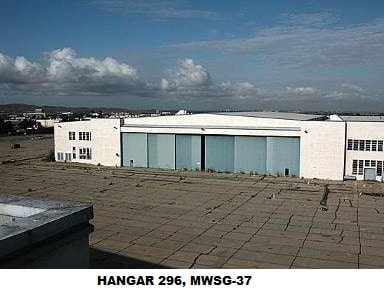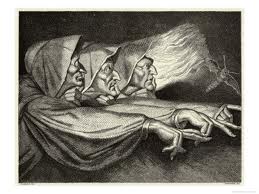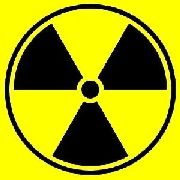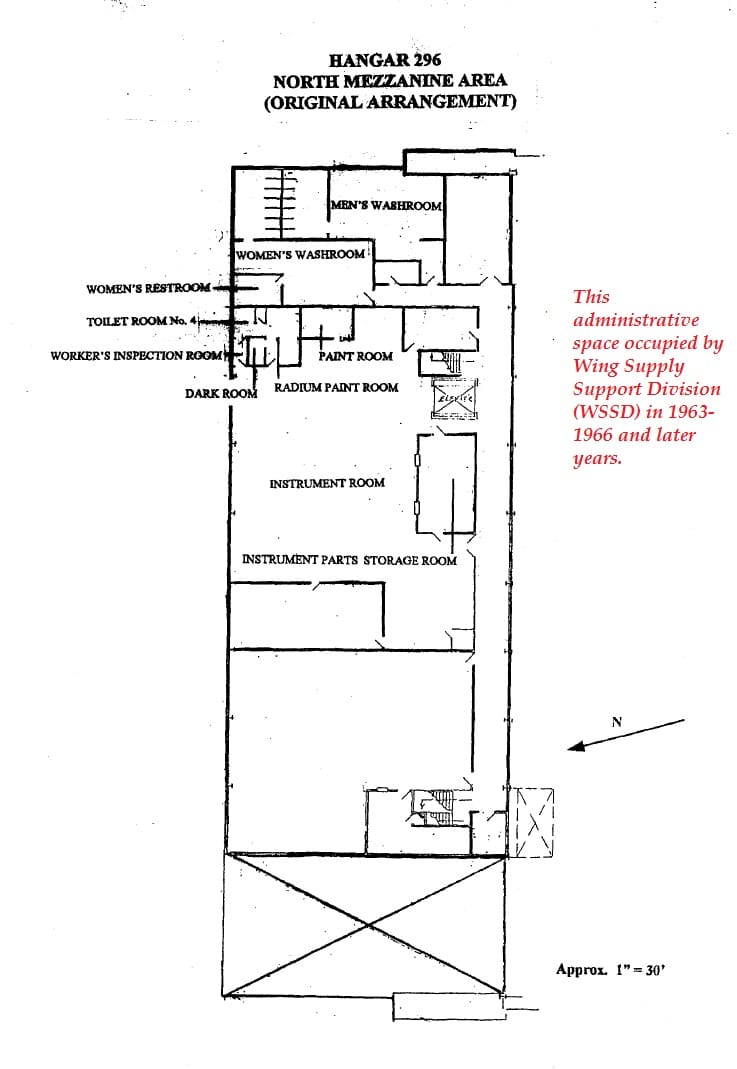by Robert O’Dowd
MCAS El Toro’s Hangar 296 was “ground zero” for TCE plume and contaminated with radiation from a Ra 226 paint room.
(IRVINE, CA) – Marine Corps Air Station (MCAS) El Toro has been an EPA Superfund since 1990, primarily from the TCE plume from Hangars 296 and 297 spreading into the Orange County aquifer.Once the premier Marine Corps jet fighter base, MCAS El Toro was closed in July 1999 and the Navy sold most of the land on the former base at a public auction for $650 million to a real estate joint venture in 2005.
jet fighter base, MCAS El Toro was closed in July 1999 and the Navy sold most of the land on the former base at a public auction for $650 million to a real estate joint venture in 2005.
Both Hangars 296 and 297 were over 200,000 square feet in area with three hangar bays and mezzanines between the bays for shops and administrative space.
TCE waste from these two hangars contaminated the aquifer under MWSG-37 and formed a TCE plume, threatening the Orange County principal aquifer off base.
In July 2002, a Navy contractor reported that the north mezzanine of Hangar 296 was contaminated with radiation (no radiation was found in Hangar 297). Radium is highly radioactive and its decay product, radon gas, is also radioactive.
Millions have been spent by the both the Navy and local government in the clean-up, an effort that will not be completed for decades.
MARINE AT EL TORO
Even though it’s been over 40 years since I worked and slept on duty watch in Hangar 296, I have vivid memories of El Toro, once the premier Marine Corps jet fighter base, and home to the 3rd Marine Aircraft Wing, relocated to Miramar in July 1999 when the base was officially closed.
Most of my memories of El Toro are good. In 1963, the Vietnam War had not consumed the country with anti-war fever; the draft was in effect and no one cut across the border to Canada to avoid military service.
The Marine who had the top bunk while I slept on the bottom at El Toro died of brain cancer on November 10, 2002, the Marine Corps birthday. We had served together right out of boot camp. I can’t forget that date. I knew his parents, his wife, and made contact with his two children, after his death.
We were not choir boys in the Corps. The first sergeant, who passed out our Good Conduct Medals in Japan, looked each of us in the eye and said “Thanks for not getting caught.”
To say that I was shocked to learn that MCAS El Toro was a Superfund site a few years ago would be a gross understatement.
I had worked for the EPA IG in the 1970s and knew that El Toro’s placement on the EPA Superfund list was not good news for anyone who lived and worked on the base, especially for someone who narrowly survived bladder cancer and seem to have multiple medical conditions not shared by his brothers and other family members.
BLADDER CANCER
I had been very lucky. Filling the toilet with blood after shoveling snow in December 2005, I knew that that I had a serious medical problem. I drove myself to the nearest ER, had a urine analysis confirming blood in my urine (something I already knew). The examining physician concerned that I might just blow this off, made it very clear on the need to follow-up with an urologist. I told him that I had seen so many urologists over the past 20 years that the AMA should erect a monument in my name or at least make me an ‘honorary urologist.’
This was a weekend. The following week, I had a cystoscopy in my urologist’s office, confirming a small tumor. Three weeks later I was operated on. The small tumor had grown and in the words of my urologist was “aggressive.” I had a good doctor. Follow-up chemotherapy was not pleasant but it worked.
The cancer remains in remission, but being a cancer survivor is a little bit ‘like looking over your shoulder’ for the bad guy to reappear and take you out.
When your life insurance agent tells you that you are uninsurable, I get the message.
For me, it was not comforting in the least to learn that the north mezzanine of Hangar 296 was contaminated with radiation from a Ra 226 paint room.
TCE and radiation? This is a little bit like ‘pick your poison,’ a game I rather not play. I didn’t get a choice of assignments in the Corps. I went where I was ordered to report to.
There is strong evidence that bladder cancer may be associated with exposure to ionizing radiation, according to scientists at the Center for Environmental Health Studies, Boston, MA.
The VA agreed that my stage 2/3 bladder cancer and hyperprolactinemia were “at least as likely as not” due to exposure to TCE/PCE and El Toro in the 1960s. But, radiation exposure may have been a factor, too.
“DOUBLE, DOUBLE TOIL AND TROUBLE; FIRE BURN, AND CALDRON BUBBLE”
El Toro was a long way in time and space from Shakespeare’s “Macbeth.” Yet, it doesn’t take much of an imagination to see the risks of toxic exposure from the heated tank in Hangar 296. If the TCE tank in Hangar 296 was not a ‘witch’s brew,’ it was the closest thing to it. The Marines who worked in the hangar had no idea of the deadly health effects of TCE.
Exposure to TCE vapors, dermal contact, and ingestion in the water supply can cause cancer and death. In an email, retired Marine Sergeant Major Bill Sears told me about a heated tank that was used to degrease aircraft parts in Hangar 296:
 “ I worked in the engine shop in Hanger 296. One of my duties was to degrease engine parts. That was done in the large tank or vat into which I periodically hoisted 55 gallon drums, using the overhead crane, and emptied the contents of TCE/PCE into the water in the tank. By heating the mixture a vapor was released into which I lowered a large metal basket containing parts to be cleaned and in seconds it was done. I have no idea how the waste was disposed of. I believe the tank was located in the attached Bldg. on the east Side of 296 as it is shown.”
“ I worked in the engine shop in Hanger 296. One of my duties was to degrease engine parts. That was done in the large tank or vat into which I periodically hoisted 55 gallon drums, using the overhead crane, and emptied the contents of TCE/PCE into the water in the tank. By heating the mixture a vapor was released into which I lowered a large metal basket containing parts to be cleaned and in seconds it was done. I have no idea how the waste was disposed of. I believe the tank was located in the attached Bldg. on the east Side of 296 as it is shown.”
In addition to organic solvents, Marines who worked in the north mezzanine of Hangar 296 were at a risk of exposure to Ra 226 and its radioactive decay products.
Ra 226 when mixed with zinc sulfide creates radioluminescent paint. The military used this mixture to paint aircraft instruments and dials.
One of the Navy’s contractors with expertise in radiological surveys and remediation is Roy F. Weston, Inc. (Weston).
Weston reported in July 2002 that Ra 226 was the principal radionuclide used in a radium room in Hangar 296. Weston noted that “instruments and equipment containing radium luminous paint were cleaned and repaired in this area.” The exact date the Ra 226 paint room discontinued its operations is unknown, but probably sometime in the 1950s.
reported in July 2002 that Ra 226 was the principal radionuclide used in a radium room in Hangar 296. Weston noted that “instruments and equipment containing radium luminous paint were cleaned and repaired in this area.” The exact date the Ra 226 paint room discontinued its operations is unknown, but probably sometime in the 1950s.
The Navy took steps to dispose of contaminated ventilation and plumbing off-base in a designated site for radioactive material. Hangar 296 is over 200,000 sq. feet in area. The area contaminated with Ra 226 was confined to portions of Hangar 296’s north mezzanine. Ra 226 was also found in the groundwater near several landfills on the base and near the hangar.
Ra 226 has a half life of 1,620 years. So even after 16 centuries half of the contaminant will still be active. Obviously, this is not something you want in your backyard.
The Nuclear Regulatory Commission is responsible for monitoring facilities under Federal jurisdiction. Since El Toro was designated for closure in 1999 and reversion to state control, the California Department of Health Services in May 1998 requested the Navy undertake a Historical Radiological Assessment for all base property.
In July 2002, the Navy requested that the California Department of Toxic Substance Control release two hangars at the former base for “unrestricted radiological use.”
Weston reported Ra 226 present in and above the radium room in the:
- Internal floor area in the common wall between the radium room and the adjacent standard paint room;
- Ventilation system ducting above the radium room; and
- Plumbing system piping below the mezzanine.
WING SUPPPLY SUPPORT DIVISON (WSSD)
Review of the Weston drawing clearly shows that the area previously occupied by the Ra 226 paint room and supporting rooms was converted to administrative work space and used by WSSD in the 1960s and possibly until the base closed in 1999.
How do I know? As Marine in the 1960s, I spent two years in the WSSD, including sleeping in the area on duty watch.
Weston didn’t report when the Navy cleaned-upped the radiation but there’s a risk that those who worked and slept on duty watch in WSSD were exposed to radiation. Bladder cancer is one of the health effects of exposure to radiation.
Marines who worked in WSSD entered the hangar through door on the west side of hangar, turn left to climb the wooden stairwells, which lead to the upper mezzanine. Some 30 feet down an open walkway lead to the entrance of WSSD, the former Ra 226 paint and supporting rooms.
A freight elevator was used to transport material from the hangar deck to the upper mezzanine. We also used the freight elevator for delivering computer punch cards to the computer room for batch processing on the lower mezzanine and for returning with computer output product the next day.
The VA disputes that El Toro’s Wing Supply Support Division (WSSD) was located in Hangar 296 and told me there’s no support for a supply clerk to work in a hangar.
My best guess is maybe 300 Marines with supply MOSs (MOS 3071 and 3072) worked in WSSD from 1969 until 1999. My estimate is based on an end strength of 30 Marines in WSSD serving a three year tour over this 30 year period. The exact number is unknown and there are no duty rosters below the squadron level so it’s unlikely that even the Marine Corps knows the number of Marines who served in WSSD.
The following is taken directly from the July 2002 Weston report:
According to (MCAS) El Toro drawings dated in the 1940’s, a radium room and supporting rooms were located in the north mezzanine of Hangar 296. Based on the drawings, it is possible that instruments and equipment containing radium luminous paint were cleaned and repaired in this area. Based on the 1940 drawings of the area, the radium facility consisted of a 1) radium room, 2) a dark room—area used to test the quality of the radium devices, 3) a worker inspection room—area used for inspection of radium devices, as well as worker egress, and 4) a toilet room no. 4—area used for both personnel wash up after working, as well as cleaning-up potentially radium contaminated equipment used in the radium room. The area previously occupied by the radium room and supporting rooms was used as office and workspaces until base closure in July 1999.
The VA needs to take a hard look at their ‘denial stamp.’ This is not news to Veterans. It’s broken. WSSD Marines worked in the administrative space previously occupied by the Ra 226 paint room, instrument parts storage room, instrument room, dark room, and men’s washroom (with shower stalls). These areas were classified in the Roy F. Weston report as either Class 1 ( areas that have, or had, a potential for radioactive contamination based on site history, or known contamination above established release limits), or Class 2 ( areas that have, or had, a potential for radioactive contamination based on site history, but are not expected to exceed established limits).
The VA has the authority and the responsibility to obtain supporting documentation from the Navy and the Marine Corps to confirm the location of WSSD Marines in the north mezzanine of Hangar 296 in the 1960s and later in time; not automatically deny a claim because there’s no reason for supply personnel to work in a hangar.
My medical doctor provided a nexus opinion to the VA for a number of chronic medical conditions “at least or more likely than not” due to radiation and organic solvent exposure at El Toro.
The VA approved compensation for bladder cancer and hyperprolactinemia “at least as likely as not’ due to exposure to organic solvents at El Toro. All claims for radiation exposure were rejected.
Dr. Bertell noted that “radon gas [a decay product of Ra 226] can pass directly to the brain via the olfactory channels. This has now been confirmed through studies of DU aerosol in the Gulf War.” Because of the risk of exposure to radon (a decay product of Ra 226) in Hangar 296, Dr. Bertell strongly recommended the VA conduct the chromosome blood breakage test, the definitive test for radiation exposure.
The chromosome blood breakage test is available from two government laboratories, the Armed Forces Institute for Science and Education, Radiation Emergency Assistance Center/Training Site and the Cytogenetic Biodosimetry Laboratory in Oak Ridge, TN.
The Philadelphia VA ignored Dr. Bertell’s advice, denying the blood chromosome breakage test for two reasons: (1) there is no support that I worked in Hangar 296 in my SRB and (2) my chemotherapy for bladder cancer (linked to organic solvent exposure at El Toro but also a heath effect of radiation exposure) negates the use of the chromosome blood breakage test.
After a news story on VT and pressure from the Department of Pennsylvania, Marine Corps League, and the Pennsylvania War Veterans Council, the VA is now reviewing their decision on the denial of the chromosome blood breakage test.
El Toro Marines who worked in the north mezzanine of Hangar 296 need to aware of their possible exposure to radiation and if there’s medical support for radiation exposure for cancer or chronic medical condition, then demand that the VA conduct the chromosome blood breakage test.
The best possible news would be that no Marine was affected by radiation exposure at El Toro.
Marines who worked in WSSD with a supply MOS (MOS 3071 and 3072) will need to support VA claims for radiation exposure in Hangar 296 with evidence that they worked in the hangar unless their SRBs contain evidence of assignment to WSSD.
CONCLUSIONS
The stupidity of putting Marines in a work space where a Ra 226 paint room operated for years is beyond my comprehension. I just learned that I slept on duty watch for two years at El Toro in what was the Ra 226 Instrument Parts Storage Room in Hangar 296. The entire WSSD staff (as many as 300 Marines over 30 years) worked in a Radium contaminated environment. Radium is about a million times as radioactive as an equivalent mass of uranium. Madam Currie’s papers are still radioactive.
A few of the unanswered questions are: how many of these men are alive today, sick with cancer or at a high risk for developing cancer in the future and have not connected the dots to service at El Toro?
There’s no health care screening for El Toro veterans. Marines who worked with toxic chemicals without protective clothing and face masks and/or were exposed to radiation are more at risk to adverse health effects than others who were stationed on the base behind some desk.
Prior to 1986 when one or more of the base wells were still part of the water distribution system and contaminated with organic solvents from well screens open in the shallow groundwater unit (the contaminated aquifer on the base), everyone on the base may have been at some risk to exposure to toxins in the drinking water. Don’t bother to ask the Navy.
The Navy’s storyline is the water was safe to drink. But, the Navy doesn’t know the dates the base wells (all in the path of the TCE plume) were abandoned, can’t find the original well construction drawings, can’t explain why a small quantity of softened municipal water was purchased for both El Toro and Tustin in 1951, what happened to 40 years of water distribution drawings, why no inspections for well screen intervals were done after Well No. 4’s well screen interval was found opened in the contaminated aquifer, and the wells were sealed in concrete.
A couple of Marine veterans and one former Air Force officer with a background in radiation and a Geiger counter did a ‘recon’ of the old hangar in 2009. No radiation present, but the contaminated roof, bulkheads, deck tile, etc. had been removed and disposed off base by the Navy.
In 2009, the State of California still refused to remove the hangar from its restricted radiological category. I’m not sure of the hangar’s present status.
Could the sewer lines be contaminated with Ra 226? If so, they will be there for a long time. The half life of Ra 226 is something like 1,600 years. Removing contaminated sewer lines to a hazardous waste disposal site would cost the Navy hundreds of millions of dollars.
Although this is an issue of potential concern for Orange County residents and I now live on the East Coast, the El Toro RAB may want to ask the Navy whether the sewer lines from Hangar 226 were tested for radiation and, if not, why not.
While there at it, the RAB may want to raise the issue of the buried drums of TCE on the former base and the decision made by the Navy not search for and remove them before they rot.
If you worked in WSSD in Hangar 296, please email me at [email protected].

Robert O’Dowd served in the 1st, 3rd and 4th Marine Aircraft Wings during 52 months of active duty in the 1960s. While at MCAS El Toro for two years, O’Dowd worked and slept in a Radium 226 contaminated work space in Hangar 296 in MWSG-37, the most industrialized and contaminated acreage on the base.
Robert is a two time cancer survivor and disabled veteran. Robert graduated from Temple University in 1973 with a bachelor’s of business administration, majoring in accounting, and worked with a number of federal agencies, including the EPA Office of Inspector General and the Defense Logistics Agency.
After retiring from the Department of Defense, he teamed up with Tim King of Salem-News.com to write about the environmental contamination at two Marine Corps bases (MCAS El Toro and MCB Camp Lejeune), the use of El Toro to ship weapons to the Contras and cocaine into the US on CIA proprietary aircraft, and the murder of Marine Colonel James E. Sabow and others who were a threat to blow the whistle on the illegal narcotrafficking activity. O’Dowd and King co-authored BETRAYAL: Toxic Exposure of U.S. Marines, Murder and Government Cover-Up. The book is available as a soft cover copy and eBook from Amazon.com. See: http://www.amazon.com/Betrayal-Exposure-Marines-Government-Cover-Up/dp/1502340003.
ATTENTION READERS
We See The World From All Sides and Want YOU To Be Fully InformedIn fact, intentional disinformation is a disgraceful scourge in media today. So to assuage any possible errant incorrect information posted herein, we strongly encourage you to seek corroboration from other non-VT sources before forming an educated opinion.
About VT - Policies & Disclosures - Comment Policy



